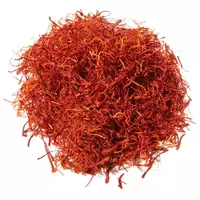Dye safflower seeds

We think many have heard about the beneficial properties of such a type of vegetable oil as safflower. However, few people know at least a little about the plant from the seeds of which a healing food product is made. Today we want to introduce you to a surprisingly useful plant for the human body called Safflour dyeing or Carthamus tinctorius. There are several varieties of the name safflower dyeing among the people. For example, safflower is often called nothing more than American or wild saffron, as well as a dye thistle.
In fact, safflower dyeing and saffron are completely two different plants. However, safflower is surprisingly similar in appearance to saffron. According to the classification adopted in biology, safflower is classified as an annual plant from the Astrov family. safflower is a plant that consists of a straight and sufficiently branched stem on which lanceolate oblong-shaped leaves grow. Safflower blooms with bright yellow-orange flowers.
The seeds of the dye safflower are contained in a special seed, which is distinguished by its tetrahedral shape. The useful properties of safflower are primarily due to the chemical composition of the plant. It is noteworthy that both dried inflorescences and dye safflower seeds are consumed as food, from which vegetable oil is made. The chemical composition of safflower dye inflorescences contains glycosides. Dye safflower seeds are enriched with fatty polyunsaturated acids of natural origin.
It is worth noting that safflower is common in the Caucasus, Crimea, as well as in some regions of the Russian Federation. In addition, the dye safflower grows in Egypt, Africa, China, Spain, as well as South America. It is noteworthy that the safflower dye plant is cultivated on the one hand for industrial purposes, and on the other hand, it is considered a weed plant. Taste, consumer, and in addition, the beneficial properties of safflower are actively used in the food industry. For example, dried safflower inflorescences are used as a coloring pigment.
From the seeds of safflower dyeing oil is produced, which is used both in the food industry and in folk or official medicine as a medicine. Safflower oil is used to produce margarine, and dried inflorescences of the plant are added to floral teas or medicinal herbal collections, as well as infusions. Safflower dyeing is part of some bile and diuretic medicines.
Safflower oil is the most popular in cosmetology. It's all about the large content of linoleic acid, which is indispensable for humans, in the chemical composition of the product. This type of fatty polyunsaturated amino acids of natural origin is not independently synthesized in the human body during vital activity. For this reason, for normal health and good health, a person needs to periodically replenish the supply of essential amino acids from food.
517 kCal safflower seeds
Energy value of safflower dye seeds (Ratio of proteins, fats, carbohydrates - ju):
Proteins: 16.18 (~ 65 kCal)
Fats: 38.45 g. (~ 346 kCal)
Carbohydrates: 34.29 g (~ 137 kCal)
Energy ratio (bj | y): 13% | 67% | 27%
 Español
Español Français
Français Português
Português Русский
Русский 简体中文
简体中文 繁體中文
繁體中文 日本語
日本語 한국어
한국어 العربية
العربية Türkçe
Türkçe Қазақ
Қазақ Deutsch
Deutsch Italiano
Italiano Українська
Українська
